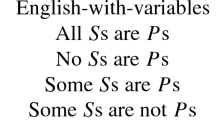Abstract
Logics that have many truth values—more than just True and False—have been argued to be useful in the analysis of very many philosophical and linguistic puzzles (as well, sometimes, in various computational-oriented tasks). In this paper, which is a followup to (Hazen and Pelletier in K3, Ł3, LP, RM3, A3, FDE, M: How to make many-valued logics work for you. Winning paper for the Canadian Schotch-Jennings Prize, one of the prizes of the Universal Logic competition in 2018; Notre Dame J Form Log 59, 2018), we will start with a particularly well-motivated four-valued logic that has been studied mainly in its propositional and first-order versions. And we will then investigate its second-order version. This four-valued logic has two natural three-valued extensions: what is called a “gap logic” (some formulas are neither True nor False), and what is called a “glut logic” (some formulas are both True and False). We mention various results about the second-order version of these logics as well. And we then follow our earlier papers, where we had added a specific conditional connective to the three valued logics, and now add that connective to the four-valued logic under consideration. We then show that, although this addition is “conservative” in the sense that no new theorems are generated in the four-valued logic unless they employ this new conditional in their statement, nevertheless the resulting second-order versions of these logics with and without the conditional are quite different in important ways. We close with a moral for logical investigations in this realm.
Similar content being viewed by others
References
Anderson, A., Belnap, N.: Tautological entailments. Philos. Stud. 13, 9–24 (1962)
Anderson, A., Belnap, N.: First degree entailments. Math. Ann. 149, 302–319 (1963)
Asenjo, F.G.: A calculus of antinomies. Notre Dame J. Form. Log. 7, 103–105 (1966)
Asenjo, F.G., Tamburino, J.: Logic of antinomies. Notre Dame J. Form. Log. 16, 17–44 (1975)
Belnap, N.: (abstract) Tautological entailments. J. Symb. Log. 24, 316 (1959)
Belnap, N.: A formalization of entailment. Ph.D. thesis, Yale University. The dissertation was published essentially unchanged as a report of the Office of Naval Research, Group Psychology Branch: Technical Report No. 7, A Formal Analysis of Entailment (New Haven, CT) (1959)
Belnap, N.: How a computer should think. In: Ryle, G. (ed.) Contempory Aspects of Philosophy, pp. 30–56. Oriel Press, Stocksfield (1977)
Belnap, N.: A useful four-valued logic. In: Dunn, F., Epstein, G. (eds.) Modern Uses of Multiple-Valued Logic, pp. 3–37. Reidel, Dordrecht (1977)
Belnap, N.: A useful four-valued logic: how a computer should think. In: Anderson, A., Belnap, N., Dunn, J. (eds.) Entailment: The Logic of Relevance and Necessity, vol. II, pp. 506–541. Princeton University Press, Princeton (1992)
Cantini, A.: Paradoxes and contemporary logic. In: Zalta, E. (ed.) The Stanford Encyclopedia of Philosophy. Metaphysics Research Lab, Stanford University. http://plato.stanford.edu/archives/fall2014/entries/paradoxes-contemporary-logic/ (2014)
Church, A.: Introduction to Mathematical Logic. Princeton University Press, Princeton (1956)
da Costa, N.: On the theory of inconsistent formal systems. Notre Dame J. Form. Log. 15, 497–510 (1974)
Dunn, J.M.: Intuitive semantics for first degree entailment and coupled trees. Philos. Stud. 29, 149–168 (1976a)
Dunn, J.M.: A Kripke-style semantics for R-mingle using a binary accessibility relation. Studia Log. 35, 163–172 (1976b)
Dunn, J.M.: The impossibility of certain higher-order non-classical logics without extensionality. In: Austin, D.F. (ed.) Analytic Philosophy: A Defense by Example, pp. 261–279. Springer, Dordrecht (1988)
Enderton, H.: Second-order and higher-order logic. In: Zalta, E. (ed.) The Stanford Encyclopedia of Philosophy. Metaphysics Research Lab, Stanford University. https://plato.stanford.edu/archives/fall2015/entries/logic-higher-order/ (2015)
Hazen, A.P., Pelletier, F.J.: K3, L3, RM3, A3, FDE, M: How to make many-valued logics work for you. Winning paper for the 2018 Canadian Schotch-Jennings Prize. In: Omori, H., Wansing, J. (eds.) New Essays on Belnap-Dunn Logic. Synthèse Library (2018)
Hazen, A.P., Pelletier, F.J.: Second-order logic of paradox. Notre Dame J. Form. Log. (2018). https://doi.org/10.1215/00294527-2018-0011
Henkin, L.: Completeness in the theory of types. J. Symb. Log. 15, 81–91 (1950)
Kleene, S.: On a notation for ordinal numbers. J. Symb. Log. 3, 150–155 (1938)
Kleene, S.: Introduction to Metamathematics. North-Holland, Amsterdam (1952)
Łukasiewicz, J.: On three-valued logic. Ruch Filozoficny 5, 170–171 (1920). English translation in J. Łukasiewicz Selected Works (ed. L. Borkowski), Amsterdam: North-Holland, 1970, pp. 87–88
Łukasiewicz, J. Philosophische bermerkungen zu mehrwertigen systemen des aussagenkalküls. Competes rendus des séances de la Société et des Lettres de Varsovie, Classe III 23, 51–77 (1930). English translation in S. McCall Polish Logic 1920–1939, pp. 40–66. (Clarendon Press: Oxford). Page references to this reprinting
Łukasiewicz, J., Tarski, A.: Investigations into the sentential calculus. Competes rendus des séances de la Société et des Lettres de Varsovie, 23, 30–50 (1930). English translation in A. Tarski Logic, Semantics Metamathematics, 2nd edition, Hackett: Indianapolis, 1983, pp. 38–59
Priest, G.: The logic of paradox. J. Philos. Log. 8, 219–241 (1979)
Priest, G.: In Contradiction: A Study of the Transconsistent. Nijhoff, Leiden (1987)
Author information
Authors and Affiliations
Corresponding author
Additional information
This paper develops some issues that are suggested but not followed up in (Hazen and Pelletier [17]). That paper was the the winning paper of the Schotch-Jennings prize, the Canadian entry into the Universal Logic prize in logic for 2018. But that paper was committed to a volume honouring the founders of the FDE logic(s), Nuel D. Belnap, Jr., and J. Michael Dunn. We are grateful to Jean-Yves Béziau for his encouragement to follow up some loose ends of that paper, so that this paper could appear in the present issue of Logica Universalis.
Rights and permissions
About this article
Cite this article
Hazen, A.P., Pelletier, F.J. Pecularities of Some Three- and Four-Valued Second Order Logics. Log. Univers. 12, 493–509 (2018). https://doi.org/10.1007/s11787-018-0214-7
Received:
Accepted:
Published:
Issue Date:
DOI: https://doi.org/10.1007/s11787-018-0214-7




